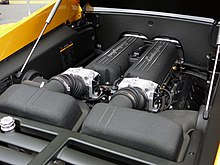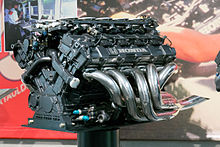Ten cylinder engine

The ten-cylinder engine is a type of reciprocating engine and is built exclusively as a V-engine for land vehicles . It can be either a gasoline or a diesel engine . Ten-cylinder, two-stroke diesel engines in ships (e.g. Wärtsilä RT-flex96C ) are in- line engines . Ten-cylinder engines are available in trucks , tanks , cars of the luxury class , sports cars and supercars . The aircraft engine by Anzani Moteurs d'Aviation (1913) is considered to be the first ten-cylinder engine .
History and Development
While eight- and twelve-cylinder engines were not uncommon in the early days of the automobile and were to be found in upper-class models of the 1930s, the introduction of the ten-cylinder engine is due to a change in the law in Germany (trucks) and a change in rules (Formula 1). As of May 1, 1965, the specific output for trucks with a total weight of 38 t was set at at least 6 hp per ton. A gradual increase to 8 hp per ton was planned from January 1, 1972; so the engine output had to be at least 304 HP for the heaviest truck combination. The cylinder output of truck engines at that time was given as 24 kW (32 PS); This specific output could not be achieved with the conventional eight-cylinder engine. Starting in 1969, Daimler-Benz built the new V10 engine with a displacement of 15.95 liters (bore / stroke: 125 × 130 mm) in its new engine plant in Mannheim, which met the requirements with 320 hp at 2500 rpm. It was built into the successful Daimler-Benz 1632 model.
According to § 35 StVZO, the minimum value of 5.0 kW / t (6.8 PS / t) currently applies , less than planned in 1972. It was not until 1992 that a ten-cylinder engine was installed in the Dodge Viper series sports car .
Formula 1 (1989-2005)
Due to a rule change in Formula 1 , exhaust gas turbochargers were banned for the 1989 Formula 1 World Championship and the displacement was limited to 3.5 liters. For the engine manufacturer, the ten-cylinder engine was the best compromise in the sum of its properties compared to the eight or twelve-cylinder engine: more power than an eight-cylinder and lower consumption than a twelve-cylinder. The McLaren MP4 / 5 won the world championship on its debut with a V10 engine (72 ° bank angle) from Honda . The competitor Renault built the V10 (RS1) with an unusual 67 ° bench angle. The V10 engine was still the successful engine design in Formula 1 after the displacement was reduced to 3 liters in 1995. In 1996, Ferrari first used a V10 with a bank angle of 75 °, similar to Peugeot and Mercedes. In 2006 , when the regulations were changed to 2.4 liters and 8 cylinders, the ten-cylinder engine was banned from Formula 1.
List of known manufacturers
truck
- Isuzu Giga (1994-2003)
-
Deutz AG and Magirus-Deutz
- F10L714 (air-cooled, 235 hp, from 1963)
- F10L814 (air-cooled, 250 hp, from 1967)
- F10L413 (air-cooled, 270 to 305 hp, from 1970)
- F10L413F (air-cooled, 320 hp, from 1977)
-
MAN
- D2530 (since 1972) (truck, emergency generator)
- D2840 (since 1997) (truck, emergency generator, DB series 706 , DB series 707 )
-
Mercedes-Benz OM 403 (1970–1987)
- Mercedes-Benz 1632
- Mitsubishi Fuso Super Great (Mercedes V10)
tank
-
MTU Friedrichshafen
- Leopard 1 MB 838 CaM (1964–1984)
- Lynx reconnaissance tank (1975–1977)
- 10V 890 (wheeled vehicles)
Pick up
- Dodge Ram (1994-2006)
- Ford F-250, F-350 and others (1997–)
Car
- Ares Panther (since 2018)
- Audi
- BMW S85
- Bristol Fighter (2004-2009)
- Dodge Viper (1992-2017)
-
ford
- Ford Shelby Cobra (2004, concept car)
- Ford Excursion (2000-2006)
- GTA Spano (since 2010)
- Hispano-Suiza V10 Supercharged (2010-2016)
-
Lamborghini
- Lamborghini Gallardo (2003-2013)
- Lamborghini Sesto Elemento (2012)
- Lamborghini Huracán (since 2014)
- Peugeot 905 (1990-1993)
- Porsche Carrera GT (2003-2006)
- Shelby GR-1 (2005, concept car)
- Toyota
- Toyota LR ( Lexus LFA ; 2010-2012)
- Toyota TS010 (1991-1993)
- VLF Force 1 (since 2016)
-
VW
- VW Concept D (1999) diesel engine
- VW Phaeton (2002-2006) diesel engine
- VW Touareg I (2002–2009) diesel engine
motorcycle
- Millyard Viper V10 (2010) motorcycle
Web links
Individual evidence
- ^ Olaf von Fersen : A century of automobile technology. Commercial vehicles. VDI-Verlag, Düsseldorf 1987, ISBN 3-18-400656-6 , p. 155.
- ↑ § 35 StVZO
- ^ Gerd Hack, Fritz Indra: Formula 1 engines. 1st edition. Motorbuch Verlag, 1997, ISBN 3-613-01803-9 , p. 54.




